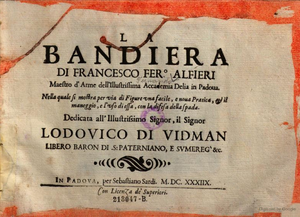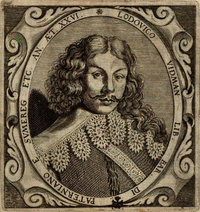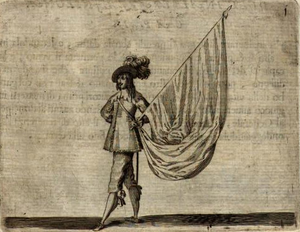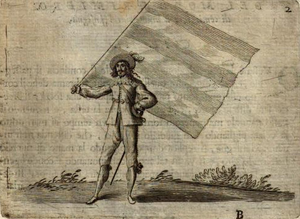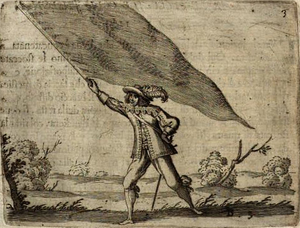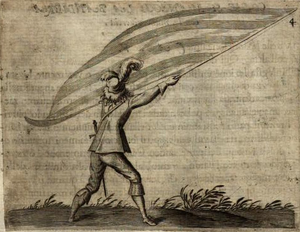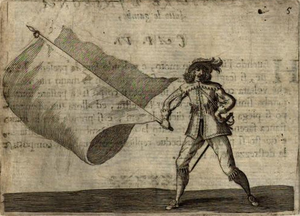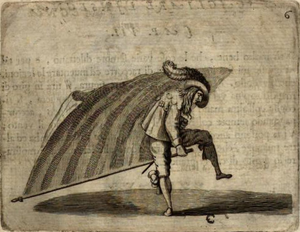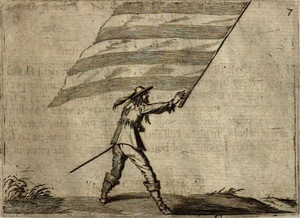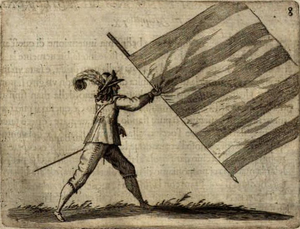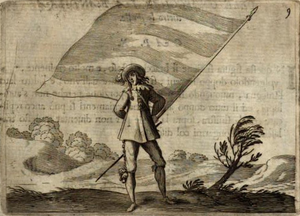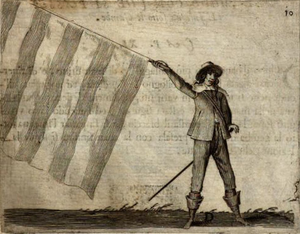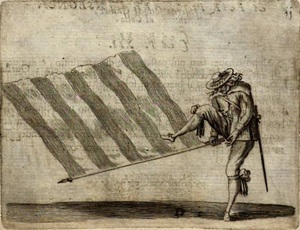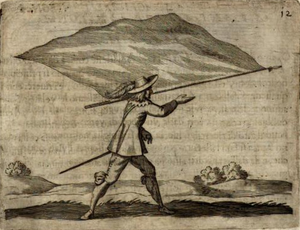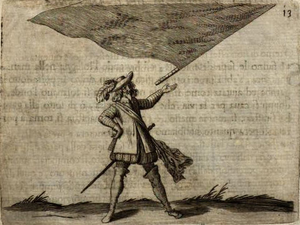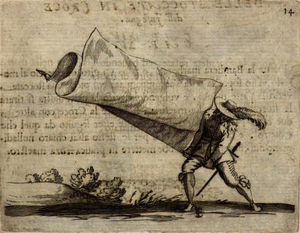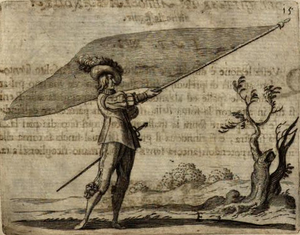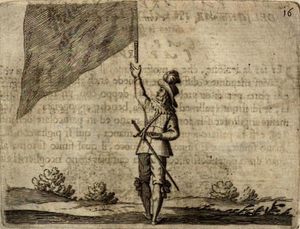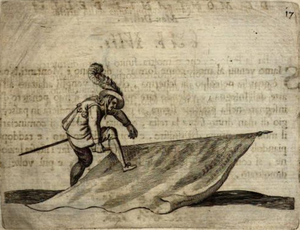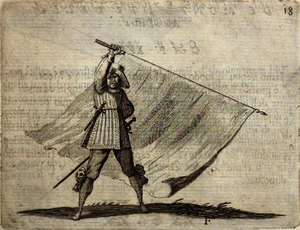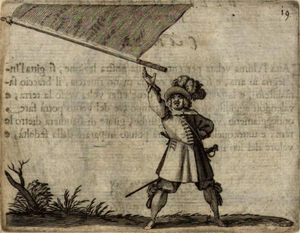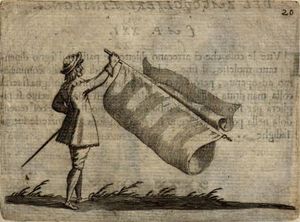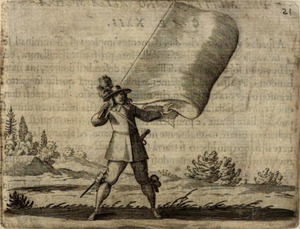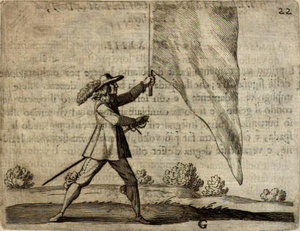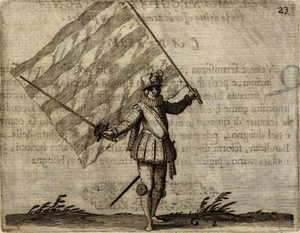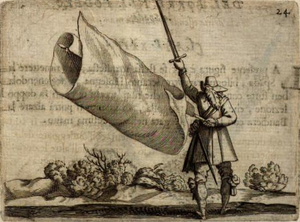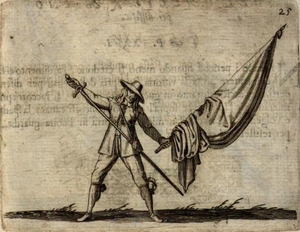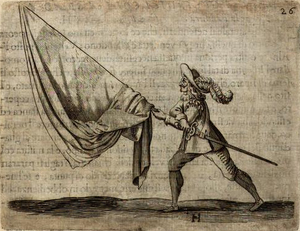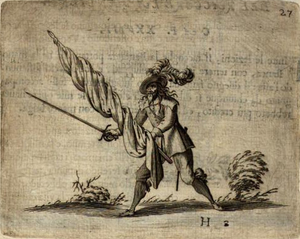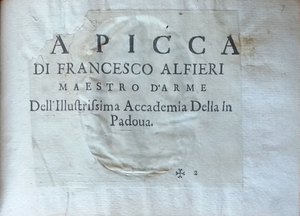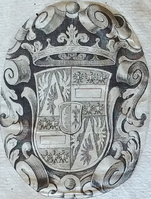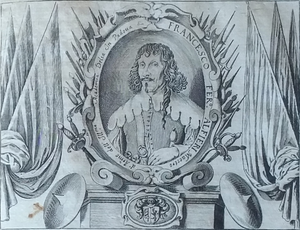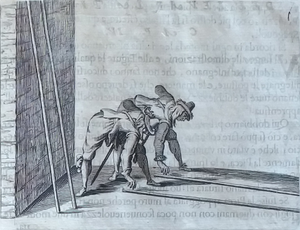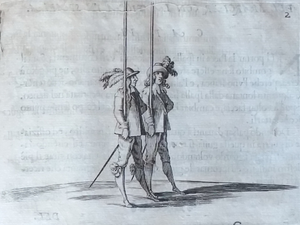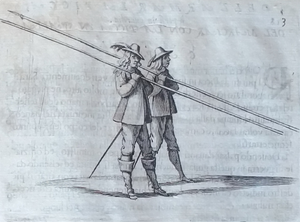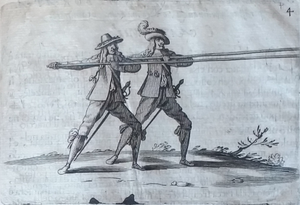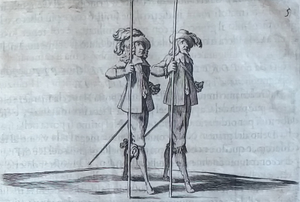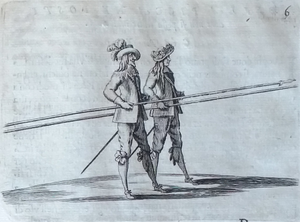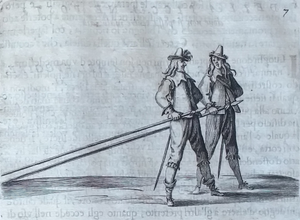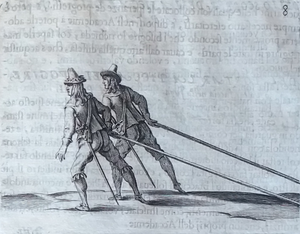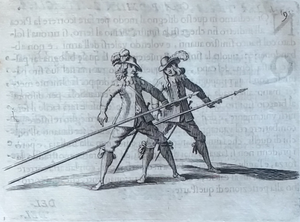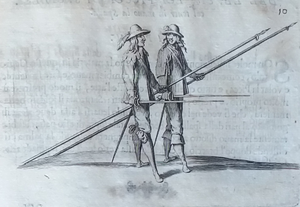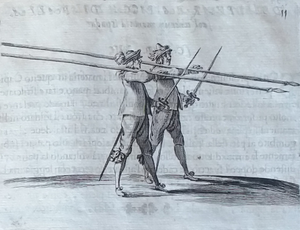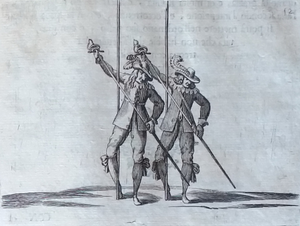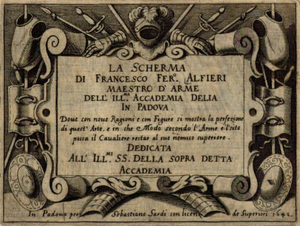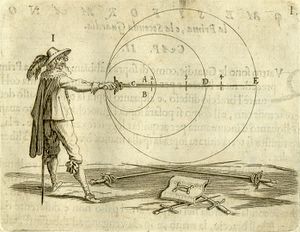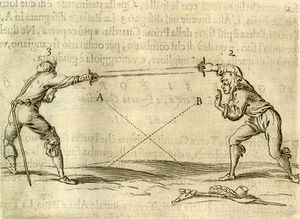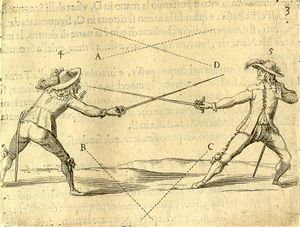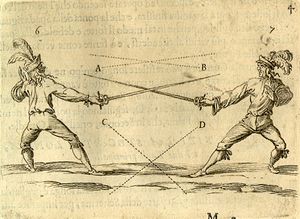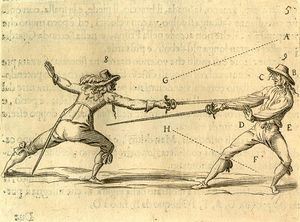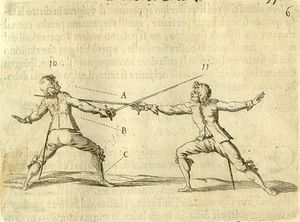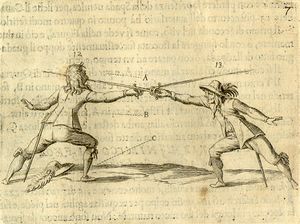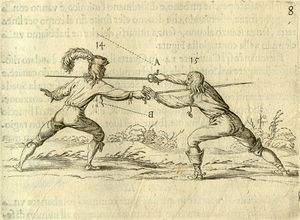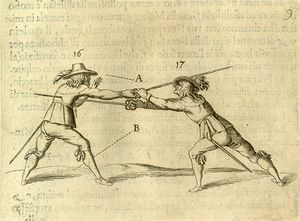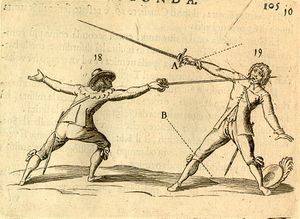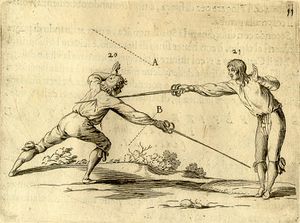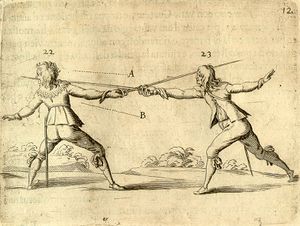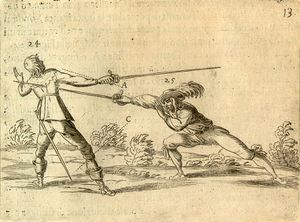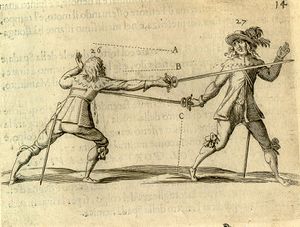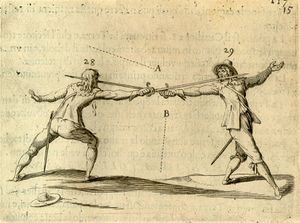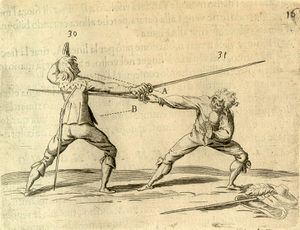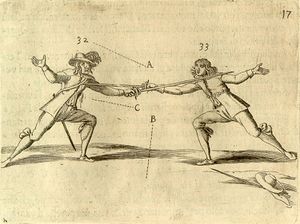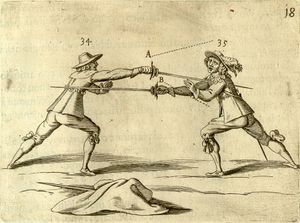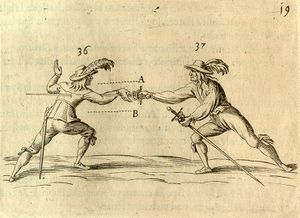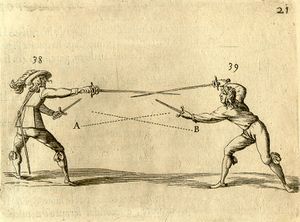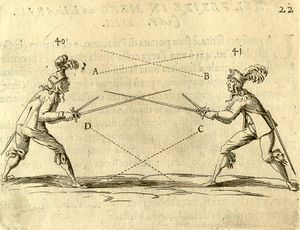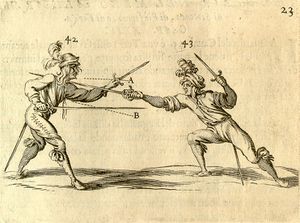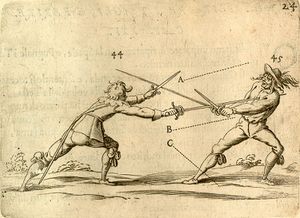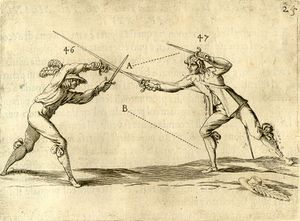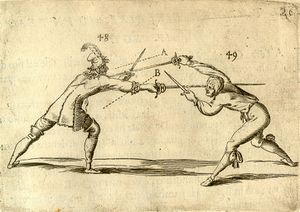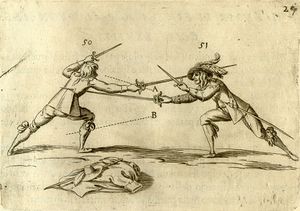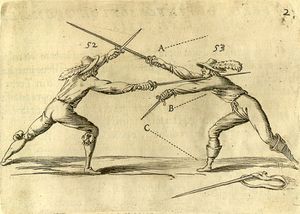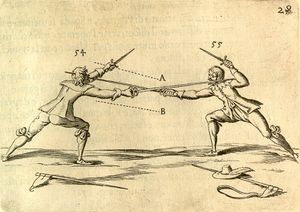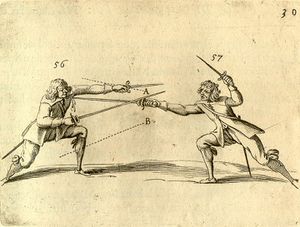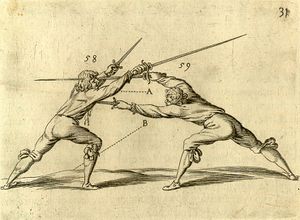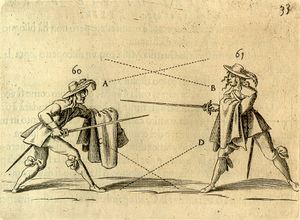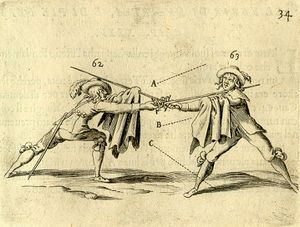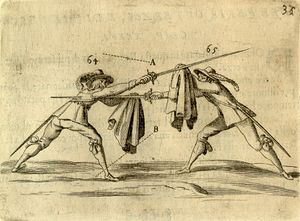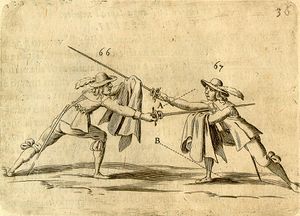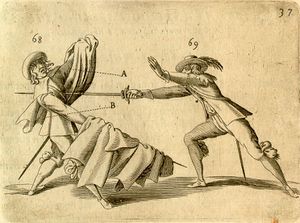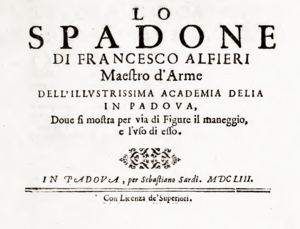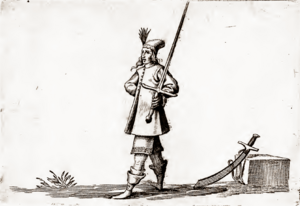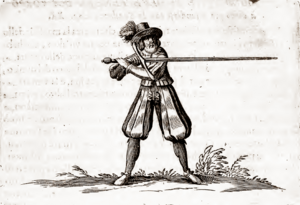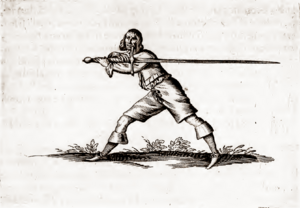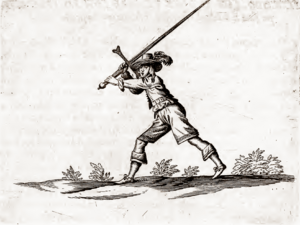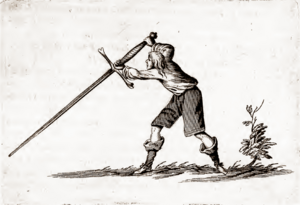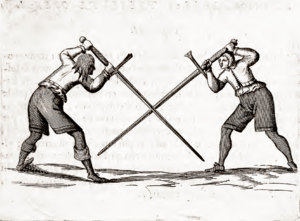|
|
You are not currently logged in. Are you accessing the unsecure (http) portal? Click here to switch to the secure portal. |
Difference between revisions of "Francesco Fernando Alfieri"
| Line 551: | Line 551: | ||
| | | | ||
| | | | ||
| − | '''Of the Spadone, by Francesco | + | '''Of the Spadone, by Francesco Fernando Alfieri''' |
'''Chapter 1''' | '''Chapter 1''' | ||
Revision as of 04:43, 8 August 2017
| Francesco Fernando Alfieri | |
|---|---|
 Portrait from 1640 | |
| Born | 16th century (?) |
| Died | 17th century |
| Occupation | Fencing master |
| Nationality | Italian |
| Genres | Fencing manual |
| Language | Italian |
| Notable work(s) |
La Picca (1641)
|
Francesco Fernando Alfieri was a 17th century Italian fencing master. Little is known about his life, but Alfieri means "bannerman" which, considering the subjects of his books, might be a military title rather than a family name. In his fencing treatise of 1640, he identifies himself as a master-at-arms to the Accademia Delia in Padua, and indicates that he had long experience at that time.
In 1638, he published a treatise on flag drill entitled La Bandiera ("The Banner"). This was followed in 1640 by La Scherma ("On Fencing"), in which he treats the use of the rapier. Not content with these works, in 1641 he released La Picca ("The Pike"), which not only covers pike drill, but also includes a complete reprint of La Bandiera (complete with title page dated 1638). His treatise on rapier seems to have been especially popular, as it was reprinted in 1646 and then received a new edition in 1653 titled L’arte di ben maneggiare la spada ("The Art of Handling the Sword Well"), which not only includes the entirety of the 1640 edition, but also adds a concluding section on the spadone.
Contents
Treatise
Images |
Transcription (1638) | |
|---|---|---|
Images |
Transcription (1641) | |
|---|---|---|
Images |
Transcription (1653) | |
|---|---|---|
[xvii] | ||
|
Of the Spadone, by Francesco Fernando Alfieri Chapter 1 It is certain, that between all these exercises and humanly arts, no practice is any more excellent nor illustrious, nor utilitarian than the martial arts. That with this, one will defend the region, expand the religion, vindicate the injustices, stabilize the peace, and facilitate the people. The ancient and famous republic, which we serve by example, and stimulates us to set out to the road that we conduct to civil happiness, they have in the meantime esteemed the art and agility that deems those which were in their solemnity judged with more force, and more velocity, than the others. We do display those gifts that we have received from nature and aggrandized with the art; these exercises were common place yet from the first centuries to the Italian nation, the exercise of the spadone is commended in as much in that the foot knows to be ready, one makes the body flexible, the hand acquires force, and one loosens the arm; we remember your origin, and who was the first, that placed it in use and aggrandized said salute, which was in the reign of Ninus, then in the Asian Cyrus, in Greece and Sparta and the Athenians, and themselves passed to Rome. Understood of possessing public academies, in which venues professors trained the youth so that not being of doubt of the ancient and marvelous effects of the Spadone, and who perfectly expect good handling and the necessary exercises in the art that otherwise has no use than to tangle and envelope the hands, which does not happen to one tested, that coming against the enemy, having readied the terms that will be appropriate to the case, making vigorous the virtue and accompanied with the vendetta. To this therefore, that without other speeches I know this virtue will easily venture to arrive at perfection that he desires, observing however the lessons of the following figures, which make clear this particularity: that hardly one can declare with words & both end this discourse of this weapon. |
[xxi] | |
|
Chapter 2: Of the art Around the Operations with the Spadone In this art one will consider the theory, and the practice; The theory is the method, how we must work with the weapon in hand against the enemy, an how one must walk with the feet, and bring the arm, and yet know to pull the body, which we learn in various and diverse manners, which serves to offend, and to defend, as one does with forehand and backhand horizontal cuts, and scalpers, montanti, strammazone, diagonals, make beats, and wheels, molinelli, bending the body and pulling the point and cuts in various and diverse guise. And as one brings, hurling, circling from one part, and hurling through the other, going forth, and you will return, in many methods that the art demonstrates, and with this exercise and study you will increase the ardor, by stretching from the people brimming with sanguine humor, brought to make injury, and who well know themselves worth this artificious weapon of the spadone, are able to go against all opposing weapons, by having it very advantageously, and in all places the man himself is able to defend, as in a large and narrow street, as in the plaza, and in the field, that he will assail the enemies before him and behind him. This noble exercise is much frequented in my school by Italian, Polish, French, and German men, and other regarded subjects of diverse nations and whom do acquire the speed and fortification with the body, and make the agility, and rouse the intelligence adorned by nature. But all studious armigers in the need can themselves be worthy of the excellence of the art, by defense of the life, and of the honor, as demonstration and discourse, and with the figure, clearly demonstrate. |
||
|
Chapter 3: Of the Use, Length, and of the Strong and Weak of the Spadone With all my power I strive, that in this little volume you do not find those things that are not appropriate for experience nor experimentation, that neither accompany from reason, for many the studious gentleman will see the following figure the variety of sites and positions of the body, feet, and spadone, and to his whole will discourse about the nature of each, and the effect that from each they are able to bare, & one will discuss these happenings that easily brings one to understand where both tempo is used and has one and other reasons, and with that advantage, and method one should go against the enemy, even that man that has science can go as he pleases; because he finds in any method the creation of good results through the understanding of the art, which is the mistress of many offenses and defenses, bringing however the spadone in due method, and later the changes and occasions given by the adversary, one has from differently performing, because this, what is good in one place is not worthy in another. It’s blade is divided in two parts, the first near the hand is of much strength, and with which you are more to defend and resist any grand blow; the second that follows somewhat more weakly, but in the offense is the principle over many, not only the point, but the cut, such that the spadone comes to be sectioned half in defense, and half in offense, and its length must be very long, as long as a proportionate man, neither tall nor short, it must have two edges and must be very light to observe of this art, pulling the blows with cuts and point with great velocity and little fatigue; yet must have great hilt-fittings to ensure the hand orchestrates the principles of operation following the nature and rules of the art. |
||
|
Chapter 4: How you will Carry the Body and Feet to Meet Against the Enemy with the Spadone The body must bring good disposition, and simple without forcing, and upright with a cheerful expression, the method that after taking the hand to the spadone is able to go against the enemy, by taking any advantage, and free himself without any danger of the enemy injuring him. |
||
| Wanting to move himself, the gentleman, to go against the adversary, must commence and carry the feet with ordinary steps, as appropriately brought forth in the stride, if well with somewhat more alacrity of motion, & the steps more brief, one will not ever enlarge their step, if not while the person is to make resistance against the enemy, than when he comes to offend, so alone as accompanied, and immediately with alacrity that is often the mother of fortune, closes the way that they are not able to come first to wound; Many have the opinion that when fighting one should look for the eyes, which I don’t understand on what it is based, seeing that never I have seen, nor understood, nor read that men are basilisks; I say that we should look at the length of the person that we intend to offend, and not just the eyes; the observation of this art can go against all sorts of honest weapons, and to resist against all kinds of adversaries, do from mastery of assisting the body and the spadone in such a way that one has more strength than the opposing weapons; however it is necessary to be abounding in starting out, to go to wound the enemy without stopping, as we shall say in their places in the following figures. | ||
|
Chapter 5: The Method the Spadone must be Held Walking It has come time to deal with the way of carrying the spadone, which is a weapon of much utility, holds the enemy back, is not subject to any prohibition, and common in every province and of every Prince and authority. Many carry it as they like, and without rule: but because there are different ways, among which we’ll show only one is best; in which one considers the walking of the feet, the motion of the stride, and disposition of the body. The time wanting it carried without tedium, without any hindrance, so at night as by day, as alone as accompanied by friends; you must seize it with the right hand, as it is nobler, and with that you will place it in the left hand, and with it you will hold it resting on the same arm, as taught by the present figure, the gentleman remaining in this posture can travel, and being assaulted one to one, or by many men, can expediently without more time grasp with the right hand, unsheathe the spadone, and rely thereon to use it as the occasion requires. |
||
|
Chapter 6: Of Gripping the Spadone: and Forming Yourself in Posture to Assail the Enemy. In this discourse one will show that it is much more effective to teach the figure: they don’t make speeches, because seeing the drawn posture and manner that one must observe by imitating them, raising all doubts that could be born from the weakness of the oppressive. The following figure represents how you must in one indivisible time stop in the posture, keeping yourself free to be able to wait or assault according to his good pleasure. Wanting the gentleman to do the first lesson, it must begin with the two principle cuts, that is a forehand and backhand, and they are brought and at the same time accompanied from the right and left hand, lengthening the step, and the body, pulling the blow either down, or up, according to the place, and the time, these two cuts are pulled indifferently, and replicated more times. The forehand are pulled from the right part, and the backhand are pulled from the left hand, and whoever will well go examining and arguing with intellect will easily find the reasons for going against every one, as we reason in a place of one, and time in another, of the other following lesson. |
||
|
Chapter 7: The First Method to Commence Handling the Spadone This lesson one will make three cuts that are worthy of being observed. One will by the subtlety and mastery of the blow seek to consider the impression of the present figure, with which he will commence the passage. And to attain the honor that one will desire, must the body be somewhat bent and disposed to the force; the arm has to be united, and take strength with both hands in gripping the spadone, and moving the natural yet generous step you will form from one time the first forehand strike, and the backhand second, and one will replicate many times such cuts, turning the body and the spadone with the hands turning over the head, and so one will go in this continuous way, both in going forward as in the return backwards, as is more effectively shown by the posture. |
||
|
Chapter 8: The Head Guard of the Spadone: For Defending Yourself in an Ordinary Street. The present figure serves to awaken the chance memory, which by the length of time and little use of my recollection given to living voice became out of mind. Now you are shown that all lessons are so ordered that one is linked with the other. Here we learn how you will pull the three cuts, making the head guard with the spadone. This not only serves to show the disposition and skill of those who exercise, but may be given the case that paragons of mastery practice it in combat. Therefore hold the arm outstretched, and give a round of three forehand cuts over the head, and the same is done with backhand cuts. You must at once spring forward without losing time. You will turn the hands together afterward, as seen in the demonstrated drawing. With the union of the right and left foot you will extend the strike, so forward as backward, having always regard for the exactness of the step so avoiding the disgrace which removes merit. |
||
| Chapter 9: How You Must in a Wide Space do the Three Crosses of the Spadone
The present lessons are all taken from the real occasions of the matter, which for most happen hot-blooded, we have come to the method of doing the three crosses. By using it in the time that you are assaulted in a plaza or a large street by several people, and to do this you all know requires much judgement, but accompanied with resolution and skill as shown in the prefixed figure. |
||
|
The first cross will be split with two cuts from the forehand, accompanying it with the right foot, rotating the body and spadone around, and every single strike causes its motion, having the left foot firmly grounded, and the other which walks with the cuts two times. And then stopping the right foot, and commence with the left foot the same with two backhand cuts, and finish the two blows you will start as before with the right foot, and if it will from here pass to the right side, pull the same two forehand cuts, and stop the right foot when finished. And the left you will put to the left side and pull its two backhand cuts, and you will return then into the same place where you had started. |
||
|
The second cross you will do with three cuts of the forehand, and with three backhand cuts. The forehand cuts will be accompanied with the right foot, and the backhand with the left foot, turning the body three times with the spadone. You will however keep the said order. |
||
|
The third cross you will do four cuts, likewise of backhand cuts, replicating four turns per part, one forward, the other to behind, and the same will be done to the right flank, and left. Observing the rule which we have established with aforesaid discourse. |
||
|
Chapter 10: Of the Handling of the Point and Cut with the Spadone There are many ways in which you can go resolutely against the enemy without stopping, and wanting to do this does by trade has great amusement. In this place we’ll show the lesson of point and cut, the principle motions are the forehand and backhand cuts, with these formed over the head, and you understand its turns with the union of the body, and of the feet, as the proposed figure shows. It begins first with the forehand cut and in the passage of the cut you will accompany the blow of the thrust, and extend it forward with the step, and the same is done from backhand cuts, so from one and the other side, replicating more times the passing with the cut and point together, and according to the occasion you will commence a new play, he could from the novelty take to this celebration, and that delight which feels the love of the virtue. |
||
|
Chapter 11: Of the Three Crosses from the Spadone’s Point and Cut I fear not being tedious in repeating the same things, than becoming obscured in leaving something out. Now come consider the figure to the practice of what you reason. But take however great marvel that in the drawing one will resemble another, this doesn’t make the art be however different to the display of its actions, although they are similar in posture. The present figure demonstrates a wonderful invention for doing the three crosses with the point and cut, and for everyone I can briefly interweave the declaration. |
||
|
The first cross you will do with two cuts, and a thrust together. You will start, such that the left foot is placed grounded. You will begin with the right foot pulling forehand cuts, and with this you will go around to return, and you will run until you have finished the two cuts, and immediately you will chain the thrust rounding the spadone behind the back, and you will put forward the strike united with the quickness of the step. So you must do with the two backhand cuts, and with the thrust together accompanied with the left foot. The same will be done from the right band, and left. |
||
|
The second cross is of three cuts, and a thrust around, and you will observe the same circumstances of foot, body, and celerity as above. First you will pull three cuts with the right foot, and a thrust, and finishing with that one you will start with the left foot, and you will do the same. This will be done forward, and back, and the right side, and left, divided into three tempos, which you will do with the right foot, and with the left. |
||
|
The third cross you will do four cuts and a thrust likewise around, which you will do forward, and behind, and to the right flank, and left. There with one foot firm, and the other turning, finishing with the right that will stop, and you will move the left, and continue until the end of the four changes, supposing always that the tempo, the step, both proportionate, without which all effort and merit is lost, and nothing more is acquired than blame. |
||
|
Chapter 12: Of the Molinello You will do with the Spadone in the Crosses All lessons are ordered, here we must learn to do the molinello in the cross. This is not only to show the disposition, but skill of whoever plays, so you must keep your arm relaxed, as shown in the following figure shown. With three montanti one knows to pass forward, and with the molinello the spadone and body will turn together, and you will return to the same position. And similar are the montanti to the right part, continue from the left side, and then the right side, doubling at your pleasure. And although the whole thing appears very clear, nonetheless, hardly anything can be put into practice without an instructor. |
||
|
Chapter 13: How You Will Handle the Spadone to Sweep the Land To do the lesson of Sweeping the Land, after you have done more steps of the forehand and backhand cuts, beginning from the right side you will make the turns of three steps with forehand arcs, and with equal skill you will return to produce the backhand cuts to the left part, and more times you will redouble according to the crowd of people, needing continually to remain in motion turning the body and the spadone there in one space, and there in another as the figure shows. And in encountering the enemy we must govern ourselves with form wanted by the occasion and the space, because in many manners you will pass to drive on, and pass from one to the other side, placing in one step good moderation, and you will not keep from becoming distinguished, experimenting in this noble exercise. |
||
|
Chapter 14: How You Will Feint Cuts from the Spadone to Deceive the Enemy And of great advantage this device is added, as is the rule of the art, to feint and to wound from cuts. The figure does not need many words, demonstrating giving a backhand cut and injuring with a forehand cut. Completing wounding with a forehand cut and striking the backhand cut, you will be able to do those steps in this lesson which you will learn from the mastery, the person can go forward, and in pulling back the blow you will stretch the crux of the hands and the force of the arms, with the step well adjusted. The feint is no different than a deception, which by itself is odious. This deception of which I speak offends neither justice nor faith, but is a rule of the art simply to beat the enemy, and is named “Feint”. |
||
|
Chapter 15: Of the Step and Sidestep With the Spadone In this Figure you will have the arm collected with the spadone to do the step and sidestep. You will make to play the body from one and the other sides, making three forehand cuts and three backhand cuts, walking the feet in the tempo which you will make the cuts, bringing them around, and extending the blow forward, obtaining with all guidance you will utilize from the speed, without confusion, and so remain forestalling the adversary. |
||
|
The fundamental principle in this lesson is to know your advantage. Traversing there from one side, and now from the other, pulling forehand and backhand cuts. Many are the enemies of truth, and they love most the new things, even such extravagance. This they make to be of great spirit, and almost reforming of this art, and don’t know that these findings have all of the ridicule, and are pernicious. And those who do not know to escape, easily remain deceived. This which I’ve taught you is always approved by those that know. |
||
|
Chapter 16: How You Must Handle the Spadone in a Large Street Danger arises from what you least believe; Boldness ends combat, but the victory is his own from virtù by protecting himself from accidents both in war and peace; turning the spadone towards the enemy, himself arranged in good guard to resist every offense. Through clarity of this lesson I show that you will begin with the natural step, and you will move three steps to the right side to assail the adversary, and with three forehand cuts you will walk forth, and three other times you will go to the left with three backhand cuts, harassing the enemy around to gain some advantage over him, and then make doing more steps, and from forehand and backhand cuts, according to the need, and in addition to this you are able to do many whims; turns, half-turns, and other artifices that are proper ornaments of the art. |
||
|
Chapter 17: Of the Method of Doing the Snake, of Forehand and Backhand Cuts with the Spadone This following figure shows the passage of the lesson, the Snake, beginning with forehand cut, and concluding the forehand cut with five steps. The same will be followed for backhand cuts, and finishing the backhand cuts, the forehand will be done with the right foot, and backhand cut with the left foot. This you will replicate more times according to the occasion, and the man will be able to defend from the many people he’s found himself against, or in a narrow street, or else in a wide street, and only with extending the arm, and bending from the body you may reach the adversary: Never wanting movements to be very fast, of body, spadone, and feet, that without any doubt this is the most secure and certain rule that in tests of such esteem, in which you will draw for life, a person can defend themselves in all places. |
||
|
Chapter 18: The Manner you must Keep with the Spadone to Make the Simple and Double Molinelli in a Narrow Street We have come to the method of how one should form the molinello with the montanti, and the non-guarding sottomani. There is no blow in fencing that cannot also be adapted to the art of the spadone, wanting to do this, which I have thought to show in the present figure, the pupil will find himself in the passage of the right flank, or left, and with montanti or sottomani turn the spadone, and make the simple molinello, walking always forward following the adversary, and pulling back if you have yourself a throng of enemies. In the double molinello you will walk with the same rule, but more times the body turns around accompanied with the same montanti and sottomani, thus in going forewards as in backwards; and I hold fast that it is a great advantage in the assault. We release the long discourse to the learned persons, because our profession constitutes more in the work than in the words; in this method, with the spadone you can advance against a shafted weapon, pike, or halberd, and win it, as I myself have done, beholding the effect in actual practice more times at different occasions to the presence of gentlemen and grand princes. |
||
|
Chapter 19: How You Must Operate the Spadone with Forehand and Backhand Cuts to Defend Yourself from Enemies on a Bridge. In handling the spadone, it seems that skill and agility prevail over force, which is manifestly understood through our figure of defending yourself on a bridge; with forehand and backhand cuts, starting with your right foot, and following with your left, turning your body and your step three times in rotation, walking forward, returning back, often depending on the situation created by the enemy, from either one side or another of the bridge, always accompanying the blows with your arm and foot, with artifice. You can also intersperse some feints or other variations, which serve to ornament the lessons, and demonstrate the spirit of the practitioner. |
||
|
Chapter 20: Of the Method that you must Keep Body to Body to Defend Yourself with the Spadone The art consists to own everything which researches the mastery of the student for using the spadone well against another that has the same weapon; against the other one must use the observations of the measure and the tempo, and yet investigate the nature and quality of the enemy’s play, and of this observation more than any depends loss and victory. Wanting the man to commence combat against the other, first he must form himself in presence of the enemy, and secondly there he moves with hostile movement, as backwards as forwards, or to the right or left flank, and like one like the other little by little, he will advance. If one pulls a forehand cut, do a forehand cut and wound with a backhand cut; and if one pulls a backhand cut, crack a backhand cut and strike a forehand cut. And observe the same for the montanto and sottomano, and as such one continues until one or the other sides leave satisfied. I do not extend to repeat this that I have more times said in advance; the principle method is taught in the present figure, leaving out nothing that has been known more for ostentation than to teach the youth. |
||
|
Chapter 21: The End of the Present Work One collects the spadone, bringing it in the left hand, as the following figure demonstrates; the drawing done by a good carver. If one were accompanied by anyone delighting of such exercise, my works would have more credit, and I would quite often be without trouble. Here is a short lesson of my promise, the summary, that to me it was in the approved principle; I am not spread out in the declarations, by not having to repeat many times the same thing, (I admit, my failing) I serve nothing less stimulating to another so intendent on discovering that which I have not known and demonstrated with this style. Whom is incapable of my genius is difficult to please in this listless century; some will regard my discovered nature that others yearn, and I am well aware that a wise man is always fair. |
For further information, including transcription and translation notes, see the discussion page.
| Work | Author(s) | Source | License |
|---|---|---|---|
| Images | |||
| Translation | |||
| Transcription |
Additional Resources
- Alfieri, Francesco Ferdinando. La Scherma: The Art of Fencing Paperback. Trans. Caroline Stewart, Phil Marshall, and Piermarco Terminiello. Pike & Shot Society, 2012. ISBN 978-1902768427
- Mondschein, Ken. The Art of the Two-Handed Sword. SKA SwordPlay Books, 2012. ISBN 978-0978902285

